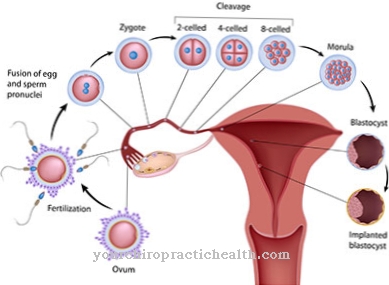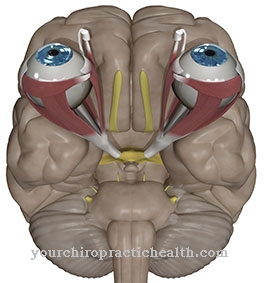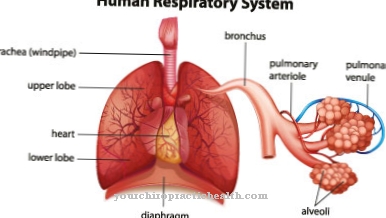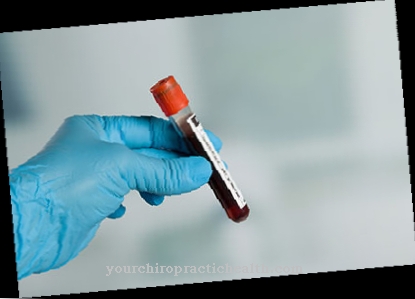Coronary heart disease (CHD), Chronic circulatory disorders of the heart muscle or Chronic ischemic heart disease is a heart disease caused by hardening of the arteries and circulatory disorders in the heart muscle. As a result, the heart is insufficiently supplied with oxygen, so that important functions of the cardiovascular system can no longer be fulfilled. Seen in this light, coronary artery disease can lead to angina pectoris or a heart attack.
What is Coronary Heart Disease?
The coronary heart disease, short CHD, is a cardiovascular disease and is known as ischemic. By and large, it is about a narrowing of the coronary arteries, as a result of which there is an undersupply of the heart muscle. If left untreated, this inevitably leads to a heart attack in coronary artery disease. It is a serious disease that is to be regarded as the cause of death in most cases in Germany.
causes
The causes of coronary heart disease belongs to arteriosclerosis, a type of calcification of the arteries. The inner walls of the vessels are narrowed by fat-laden material, in which the life-threatening lime is later deposited. Due to the narrowing of the blood vessels, the blood cannot circulate and tissue particles die as a result.
This condition is known as arteriosclerosis, but it can also spread to all blood vessels. When this happens and the heart vessels are affected, experts speak of coronary heart disease. People who are heavy smokers are also at great risk of developing coronary heart disease. This also applies to people who eat high fat, suffer from high blood pressure and are under constant stress.
Further causes of coronary heart disease can be seen in the disease picture obesity (overweight). With these symptoms, the cholesterol levels of the patients are not infrequently increased and they suffer from an efficient disruption of the lipid metabolism. Coronary heart disease can also be caused by high sugar levels, as occurs in diabetes mellitus.
Symptoms, ailments & signs

© Henrie - stock.adobe.com
Coronary artery disease (CHD) can manifest itself in different symptoms. It is important to know here that the signs can be very unspecific, especially if the disease is not yet advanced. This means that a symptom such as paleness can indicate, for example, an iron deficiency, a cold, too little sleep, but also coronary artery disease.
Clarification by the family doctor or, if necessary, a specialist is therefore important in the event of persistent or worsening symptoms. This applies in particular if risk factors such as obesity, smoking or heart attack or stroke in the family are added to the symptoms.
A typical symptom of coronary artery disease is angina pectoris. The term refers to chest tightness that can, but does not have to, radiate into the neck and jaw, arms and shoulders. There are also silent courses of CHD. Often this tightness is also associated with anxiety, sweating or a drop in blood pressure, known as hypotension.
A fast heartbeat (medical term: tachycardia) and shortness of breath (dyspnea) are classic signs. In women, the symptoms are often less specific. Upper abdominal discomfort, paleness or nausea can also indicate angina pectoris. Therefore, in case of doubt, a visit to the doctor is always advisable in order to rule out coronary artery disease and its sometimes dangerous complications or to treat it with suitable measures.
Course of disease
The course of a coronary heart disease is always chronic, because the advanced arteriosclerosis results in a slowly progressive deterioration of the clinical picture. At the same time, in most cases, the quality of life of the affected patients also sings. The first signs of coronary heart disease are not that easy to recognize because the disease progresses insidiously.
Apparently there is only shortness of breath during exertion, which occurs due to the insufficient supply of blood to the heart. The patients feel a feeling of tightness in the heart area, experts speak of angina pectoris in this case.
Complications
Coronary artery disease (CHD) can cause serious complications. One of the early effects is heart instability, which is associated with abnormal heart rhythms. Acute myocardial infarction is a particularly serious complication of CHD. The reason for this is the narrowing of the coronary arteries within the vascular wall due to the build-up of plaque.
If the plaque ruptures abruptly, the blood coagulates locally, which causes the plaques to accumulate. After that, it doesn't take long until the affected coronary artery is closed. Oxygen deficiency occurs in those parts that have previously been supplied by this coronary vessel, which doctors call acute coronary insufficiency.
An acute heart attack usually manifests itself through sweating, shortness of breath, nausea and a feeling of fear of death. In such a case, a hospital with a cardiac catheter laboratory must be visited immediately. Ventricular fibrillation is also one of the serious effects of CHD. This is evident in around 80 percent of all people who die from a heart attack due to cardiac arrest. The risk of this complication is particularly pronounced in the first hours of the infarction.
A subsequent sequela of coronary heart disease is the heart rupture, in which the heart muscle wall ruptures. A bruise appears inside the pericardium.
When should you go to the doctor?
If symptoms such as palpitations, breathlessness, and sweating are noticed, the cause may be coronary artery disease. Medical advice is required if the symptoms persist for more than a few days or if they increase in intensity. If there are other symptoms and complaints, such as chest pain or nausea, it is best to consult your family doctor immediately. Nonspecific symptoms that impair wellbeing and quality of life should also be clarified quickly.
People who suffer from atherosclerosis are particularly susceptible to the development of coronary artery disease and should have these symptoms examined quickly and, if necessary, treated. The same applies to diabetes and high blood pressure patients. An unhealthy lifestyle is associated with an increased risk of developing heart disease, which is why smokers, people with obesity and alcoholics must also seek medical advice. The right contact person is the family doctor or a cardiologist. If the disease is well advanced, it may need treatment at a specialist heart clinic.
Treatment & Therapy
You can Coronary heart disease Therapy with medication or surgery. This is basically decided by the doctors after the course and status of the disease have been clearly established.
The severity of the coronary heart disease plays the major role. In drug therapy, drugs such as clopidogrel, beta blockers, ACE inhibitors, statins and, of course, acetylsalicylic acid are used, which have the sole aim of lowering cholesterol levels. An existing angina pectoris is treated with a nitroglycerine spray.
Surgical therapy aims to improve blood flow to the heart muscle. Doctors usually use a bypass for this. A coronary angioplasty with subsequent use of a coronary stent can also be performed as therapy. This medical implant is particularly suitable for expanding small constrictions of the vessels.
In this very special way, the expected new occlusion of the blood vessels is efficiently prevented. These stents are not only available as supportive stents but also as coronary stents that release active ingredients that can additionally reduce or even prevent occlusion of the blood vessels.
Outlook & forecast
In practice, it has been shown that bypasses (grafts) made from arterial material are more stable than bypasses made from veins. Over 90% of the grafts from arteries are still completely pervious 10 years after the operation. In contrast, bypasses from leg veins are only 70% free in the same period.
Since the cause of coronary heart disease, arteriosclerosis, cannot be cured, the patient has to adapt his lifestyle appropriately. Risk factors must be minimized in order to have a good prognosis for the future and not to endanger the success of the operation. This of course includes regular medical checks of the status quo.
Furthermore, you have to pay attention to your body weight, because being overweight would have a negative effect. Nicotine and alcohol consumption should be stopped if possible. The reduction of stress has a positive effect. To do this, it makes sense to familiarize yourself with various stress management methods. Regular exercise and sport promote a good cardio situation. Health insurance companies also offer special courses such as cardiac sports groups that are worth attending. Fats should be avoided when preparing food. Here the patient can orientate himself well to the Mediterranean cuisine. In general, patients should pay close attention to their own body signals and, if in doubt, consult their cardiologist or family doctor.
prevention
How can you take the risk of a coronary artery disease reduce or prevent? With the help of the following points, the risk of a heart attack and other heart diseases can be reduced significantly:
1. You should have your blood pressure measured regularly. Adults over the age of 40, in particular, should have their blood pressure checked at least once a year. Too high blood pressure puts a strain on the heart. Values below 130 to 80 are considered good.
2. One should eat healthily. A conscious and healthy diet reduces the risk of a heart attack. On saturated fatty acids, especially in animal products such as butter, cream, pork, etc. a. should be avoided as these increase the level of cholesterol in the blood.
3. You should do enough exercise. In particular, light endurance sports such as Nordic walking, cycling or swimming reduce the risk of heart attacks.
4. If you are overweight, you should reduce this excess weight. Already 10 kilos too much have a negative effect on our health, both blood pressure and blood lipid levels increase.
5. You should give yourself a smoking ban. Just six cigarettes a day double the risk of a heart attack, so stay away from it!
6. You should also avoid stress as much as possible. Basically, the body can withstand stressful situations, but you shouldn't overdo it here, as these can lead to high blood pressure.
Aftercare
For coronary artery disease, follow-up care is almost as important as therapy. Patients need consistent follow-up care so that the findings do not worsen as much as possible. Regular checks by the treating physician are therefore essential. In this context, professional contacts are the internist or cardiologist, but also the family doctor. The nearest clinic is the right address for acute complaints.
Coronary artery disease often has behavioral causes. These must be included in the practice of aftercare to prevent further crises. Refraining from nicotine and too much alcohol is particularly important here. In addition, patients must also ensure a low-fat diet with plenty of fruit and vegetables in order not to let blood lipids rise to an unhealthy level and not to endanger health any further. The competent nutritional advice offers help.
Weight and fitness should also be included in the aftercare. Weight reduction and fitness building can be achieved through targeted physical activity. Lightly dosed endurance training or strength training with not too much weight are often helpful, but should always be coordinated with the attending physician. Coronary sports groups with qualified trainers are specially tailored to the needs of cardiac patients. Stress reduction is another important factor in the consistent follow-up care of those affected by coronary disease.
You can do that yourself
In addition to drug treatment, a healthy lifestyle makes a significant contribution to maintaining quality of life for a long time despite coronary heart disease.
The diet should be varied and varied, fiber-rich food with lots of fruit, vegetables and whole grain products is preferable to foods rich in fat and carbohydrates. Unsaturated fatty acids have a more positive effect on blood fat levels than saturated fatty acids, which are found in fried foods and meat products. Good examples of the preparation of healthy meals are provided by the Mediterranean cuisine, in which animal fats are replaced by vegetable oils and salt by spices.
It is also important to reduce risk factors: completely avoiding nicotine can significantly increase life expectancy, alcohol should only be consumed in moderation. Physical activities help to reduce excess weight, improve stamina and lead to a positive attitude towards life. Endurance sports such as cycling, jogging or swimming are ideal, and quick walking also has a positive effect on the heart and circulation. Several short units per week are more effective and gentler than a long one, the intensity must be adapted to your own performance. If in doubt, it is advisable to work out a training plan together with the attending physician.
Stress and hectic rush harm the heart, so there should be enough space for rest and relaxation in everyday life. Maintaining social contacts also promotes well-being.


.jpg)





















.jpg)



